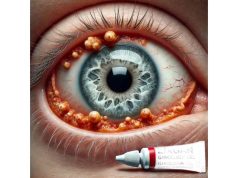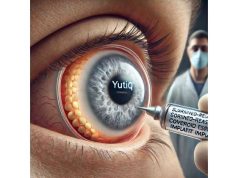
Corneal mucous plaques are a visually disruptive and often uncomfortable manifestation on the eye’s surface, typically signaling underlying ocular inflammation, infection, or chronic irritation. These sticky, white or grayish deposits can cause blurred vision, foreign body sensation, and even pain, impacting daily life and ocular health. Understanding the causes, available therapies, and advanced treatment strategies is key for both patients and clinicians. This comprehensive guide offers up-to-date, practical information about corneal mucous plaques—from underlying mechanisms to the latest research shaping the future of eye care.
Table of Contents
- Understanding Corneal Mucous Plaques and Predisposing Factors
- Mainstream Treatment Strategies and Medication Options
- Operative Removal and Interventional Solutions
- Innovative Therapies and Emerging Technologies
- Clinical Research Updates and Future Directions
- Frequently Asked Questions
Understanding Corneal Mucous Plaques and Predisposing Factors
Corneal mucous plaques are accumulations of mucin, epithelial debris, inflammatory cells, and proteinaceous material that adhere tenaciously to the corneal surface. Unlike typical corneal opacities or scars, these plaques are often removable but tend to recur unless the root cause is addressed. They may appear as whitish, translucent, or gelatinous patches, often irregular in shape and variable in size.
Pathophysiology and Mechanisms
- Plaque formation is usually a response to chronic ocular surface inflammation or epithelial injury.
- Common triggers include persistent infections (especially herpes simplex or herpes zoster keratitis), dry eye disease, chronic conjunctivitis, corneal ulcers, and bullous keratopathy.
- Mucous and cellular debris become trapped in areas where the corneal epithelium is damaged or where healing is delayed, creating a sticky matrix.
Epidemiology and At-Risk Groups
- More frequently seen in adults and the elderly, especially those with chronic eye disease.
- Patients with immune deficiencies, diabetes, or those using long-term topical medications are at elevated risk.
- Prevalence is higher in geographic regions where certain infectious keratitides are common.
Risk Factors
- Chronic ocular inflammation (from infection, autoimmune conditions, or allergy)
- Poor eyelid closure or exposure keratopathy
- Neurotrophic (nerve-related) corneal disorders
- Prolonged use of contact lenses, particularly if hygiene is inadequate
Symptoms
- Blurred vision or visual disturbance
- Foreign body sensation, discomfort, or mild pain
- Visible white/grayish patch on the cornea, especially with slit-lamp examination
Practical Advice:
If you notice persistent cloudy spots or discomfort in your eye, see an eye specialist promptly. Early intervention can prevent complications and improve your comfort.
Mainstream Treatment Strategies and Medication Options
The foundation of corneal mucous plaque management is addressing both the plaques and their underlying cause. Most cases improve with a combination of medical therapies, lubrication, and, when necessary, gentle removal of the plaque.
Non-Surgical Medical Treatments
- Lubricating Eye Drops and Ointments:
- Help loosen plaques by hydrating the corneal surface and reducing friction.
- Used frequently throughout the day and at bedtime for sustained effect.
- Tip: Preservative-free options are ideal, especially for sensitive eyes or chronic use.
- Topical Anti-Inflammatory Medications:
- Steroid or cyclosporine drops may be prescribed to reduce inflammation and promote epithelial healing in select cases.
- Caution: Prolonged steroid use can raise eye pressure and increase infection risk; regular monitoring is essential.
- Antiviral or Antibiotic Eye Drops:
- Essential if the underlying cause is infectious keratitis.
- Example: topical acyclovir or ganciclovir for herpes simplex; broad-spectrum antibiotics for bacterial causes.
- Mucolytic Agents:
- Acetylcysteine (5–10%) drops, though not universally available, can break down mucous and assist in plaque removal.
- Artificial Tears with Mucin Layer Enhancers:
- Newer formulations help stabilize the tear film, preventing plaque re-formation.
Practical Steps for Home Care
- Maintain strict hand hygiene to prevent infection.
- Avoid rubbing or touching your eyes.
- Adhere to medication schedules and follow up as advised.
Limitations
- Plaques may recur unless the primary condition is treated.
- Some patients require a stepwise escalation in therapy for optimal control.
Long-Tail Keywords Used Here:
- best eye drops for corneal mucous plaques
- home remedies for corneal plaque
- medical treatment for eye mucus spots
Operative Removal and Interventional Solutions
For stubborn or vision-impairing corneal mucous plaques that do not respond to medical therapy, minor procedures may be necessary to clear the visual axis and improve comfort.
Office-Based and Surgical Approaches
- Mechanical Debridement:
- Performed under topical anesthesia, the plaque is carefully loosened and lifted off with a sterile spatula or forceps.
- Quick, generally painless, and often provides immediate symptom relief.
- Sometimes, an amniotic membrane may be applied post-debridement to speed up corneal healing.
- Adjunctive Treatments During Debridement:
- Application of mucolytic drops or antibiotics to the exposed corneal surface after plaque removal.
- Placement of a therapeutic (bandage) contact lens to promote epithelial healing and comfort.
- Repeated Debridement:
- In chronic or recurrent cases, debridement may be needed more than once, always paired with aggressive control of the root cause.
- Superficial Keratectomy:
- For very persistent or thick plaques, a superficial surgical polishing of the corneal surface may be considered. This is a minor procedure, usually performed in an outpatient setting.
Laser Therapies
- Rarely, excimer laser ablation may be used for resistant cases, especially where the plaque is tightly adherent and vision is significantly affected.
Risks and Aftercare
- Mild discomfort or light sensitivity is common post-procedure.
- Strict adherence to prescribed drops and ointments helps prevent infection and promotes faster healing.
Practical Advice:
Arrange for a ride home if you undergo an in-office procedure, and avoid swimming or dusty environments during the healing period.
Long-Tail Keywords Used Here:
- debridement for corneal mucus plaques
- superficial keratectomy for eye plaques
- minor eye surgery for mucus buildup
Innovative Therapies and Emerging Technologies
Exciting advances in ocular surface medicine are providing new hope for those with recurrent or severe corneal mucous plaques. These innovative approaches offer more targeted and effective options for both plaque management and underlying disease control.
Novel Medical Developments
- Advanced Mucolytics and Tear Film Stabilizers:
- Research is exploring next-generation mucolytic agents, including sustained-release formulations and combination therapies, for more effective plaque dissolution.
- Biological and Regenerative Therapies:
- Amniotic membrane eye drops and biologic tear substitutes have shown promise in restoring the corneal surface and reducing plaque recurrence.
- Stem cell-based eye drops and patches are being studied for their regenerative potential in healing persistent epithelial defects.
- Smart Drug Delivery Systems:
- Nanotechnology-based eye drops and contact lenses are under development to deliver medications directly to the corneal surface, maximizing efficacy and minimizing side effects.
AI and Diagnostic Innovations
- Artificial Intelligence in Ocular Imaging:
- AI-enhanced anterior segment imaging helps detect and track plaque formation earlier, allowing clinicians to tailor interventions more precisely.
Laser and Device-Based Solutions
- MicroPulse and Low-Energy Lasers:
- These technologies may selectively disrupt or loosen mucous plaques with minimal collateral damage, offering a non-invasive alternative for select patients.
Practical Advice:
If you have recurring mucous plaques, consider asking your ophthalmologist about clinical trials or new therapies that may be available in your region.
Long-Tail Keywords Used Here:
- new treatments for corneal mucous plaques
- stem cell therapy for eye mucus
- AI in diagnosing corneal diseases
Clinical Research Updates and Future Directions
Ongoing research and innovation continue to improve the outlook for patients with corneal mucous plaques. Clinical trials and pipeline therapies are focused on preventing recurrence, restoring vision, and making treatment more accessible worldwide.
Active and Upcoming Clinical Trials
- Innovative Mucolytics:
- Studies are underway evaluating new, longer-lasting mucolytic drops for stubborn mucous plaques, including those associated with chronic viral keratitis.
- Regenerative Medicine Approaches:
- Clinical trials are assessing stem cell-based treatments, biologic tear substitutes, and amniotic membrane products for resistant ocular surface disease.
- AI-Driven Diagnosis and Remote Monitoring:
- Tele-ophthalmology platforms and AI algorithms are being tested for early identification, monitoring, and patient self-management support.
Expected Advances in Care
- Less frequent need for mechanical procedures thanks to better topical and regenerative therapies
- Earlier intervention with AI-supported diagnostics
- Personalized medicine based on molecular or genetic analysis of the ocular surface
Getting Involved
- Ask your eye care provider about participation in clinical trials or registries.
- Stay informed via reputable eye health organizations and research groups.
Long-Tail Keywords Used Here:
- clinical trials for corneal plaque treatments
- new research on eye mucus removal
- future therapies for corneal surface disease
Practical Advice:
Stay proactive by scheduling regular eye checkups, especially if you have a history of ocular surface problems. Being informed helps you and your provider make the best choices.
Frequently Asked Questions
What are corneal mucous plaques and what causes them?
Corneal mucous plaques are sticky deposits made up of mucin, dead cells, and inflammatory material that collect on the corneal surface, usually as a result of chronic irritation, infection, or persistent eye surface disease.
How can I remove corneal mucous plaques at home?
While lubricating eye drops may help loosen minor plaques, it’s important not to try to remove them yourself. Professional removal by an eye care provider is safest to avoid injury or infection.
What is the best treatment for corneal mucous plaques?
Treatment often starts with lubricating eye drops, mucolytic agents, and addressing the underlying disease. In some cases, gentle in-office removal is needed, followed by medications to prevent recurrence.
Are corneal mucous plaques dangerous?
While not usually dangerous by themselves, they can impair vision, cause discomfort, and indicate underlying eye disease needing attention. Prompt evaluation ensures proper care and prevents complications.
Can corneal mucous plaques come back after removal?
Yes, recurrence is common if the root cause—such as dry eye, infection, or inflammation—is not treated. Regular follow-up and ongoing management are key to prevention.
Is there a permanent cure for corneal mucous plaques?
Most cases can be controlled, but a “permanent cure” depends on managing the underlying condition. New therapies like regenerative medicine and advanced mucolytics offer hope for more lasting results.
Are there any new or advanced treatments for corneal mucous plaques?
Recent advancements include next-generation mucolytic agents, stem cell-based therapies, amniotic membrane eye drops, and AI-powered diagnosis, all aimed at more effective, long-lasting plaque control.
Disclaimer:
This article is intended for educational purposes only and should not be used as a substitute for medical advice, diagnosis, or treatment from a qualified professional. Always consult your eye care provider for any vision concerns or before starting or changing therapy.
If you found this guide helpful, please share it with friends or on your favorite social media platform—Facebook, X (formerly Twitter), or others. Your support helps us continue creating accessible, quality content for everyone interested in eye health. Follow us for the latest updates and tips—thank you for your encouragement!










